Does the Sun hate us, or love us? On one hand it bestows light, warmth, tans, vitamin D, and generally makes life both possible and worth living. Yet then it burns and ages our skin, and gives us cancer. Talk about mixed signals.
We all know to protect ourselves against too much sun, particularly in summer. In this article I dig a little deeper into sun exposure, and what it means for your time outdoors.
Why do we get sunburnt?
In short, it’s the sun messing with our DNA.
The sun throws out a stupendous amount of energy. A minuscule fraction hits the Earth. Some we can see (visible light) but most forms we can’t. It’s one of these forms, ultraviolet (UV), that causes sunburn.

Ultraviolet rays penetrate our skin. Our cells absorb the rays and convert their energy into harmless heat. A tiny, tiny percentage of the rays aren’t converted fast enough, which can cause part of the cell’s DNA to scramble.
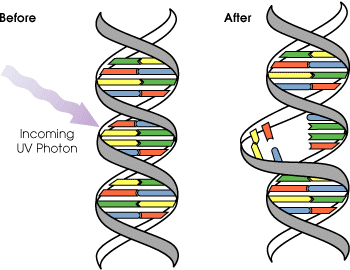
What we call sunburn is our body responding to this DNA damage:
- To make us protect the injury, the body lowers the threshold for sending pain signals from pressure and temperature. That causes the discomfort of sunburn, and why often its first noticed under a hot shower.ref
- Damaged cells begin to repair. The extra blood flow for healing is why sunburned skin is red and warm.
- Cells that cannot repair self-destruct and shed. Normally skin cells are invisible, but so many cells are killed by a bad sunburn that we can see them being shed in the form of peeling skin.
There are some mind-boggling figures involved. Despite our body neutralising almost all incoming UV radiation, even the mildest detectable sunburn means hundreds of thousands of DNA errors. Per cell. And you have a lot of cells.ref
Rarely, breath-takingly rarely, DNA will be damaged in a way that can’t be repaired and also prevents the cell’s destruction. Instead, the cell begins to replicate, and a cancer has begun.
Can we feel when we’re getting sunburnt?
No, not really.ref
Ultraviolet cannot be seen or felt by humans. While we can detect its effect via sunburn, for most people these sensations are delayed by 2-6 hours. By the time sunburn is felt, it’s too late.
Hopefully you’re not still in the sun when you first notice you’ve been burnt, but either way the painful effects won’t peak until 8-24 hours after exposure.ref It’s going to get worse before it gets better.
Are hot days more dangerous?
No. At least not because they are hot.
The main driver of potential sun damage is how high the sun is in the sky. When the sun is high, more energy is reaching you. As illustrated below, this is because the sun’s energy is more concentrated, and has less atmosphere to travel through (which means less chance to be blocked by dust, clouds etc.).
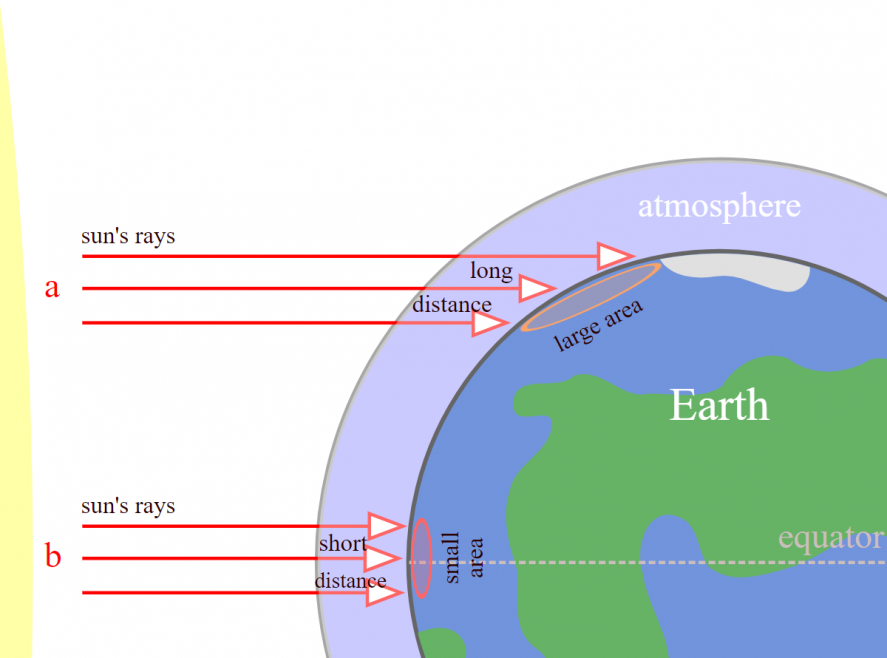
Of course, a high sun (like at midday, or in summer) tends to mean more heat, but not always. For example, while maximum UV occurs around midday, temperatures usually don’t peak until later in the afternoon.ref
Does the sun burn quicker in some countries?
Sort of.
In general, how fast you burn depends on your latitude. Towards the equator the sun is higher and the ozone layer thinner, so head that way and you’ll burn quicker. But move east or west around the world and you’ll burn at the same rate.
Beyond this generalisation, other factors include:
- Altitude, which increases UV exposure by around 12% per km.
- Clouds are less effective at blocking UV than light and heat, and can even increase UV. But generally, UV levels on an overcast day are around 2/3rds lower. The reduction diminishes as the cloud cover becomes patchier, thinner, and higher. ref
- Daily and seasonal ozone fluctuations, as packets of air with differing ozone content move around the upper atmosphere.
- Water is a powerful barrier. Less than half the UV makes it below the first 50 cm of water. Though in terms of personal sun safety, this is probably only relevant to nude SCUBA divers.
- Surfaces can reflect addition UV towards you. Most surfaces aren’t very reflective, as the table below shows, with the notable exception of snow, which can reflect up to 80% of the UV it receives.ref
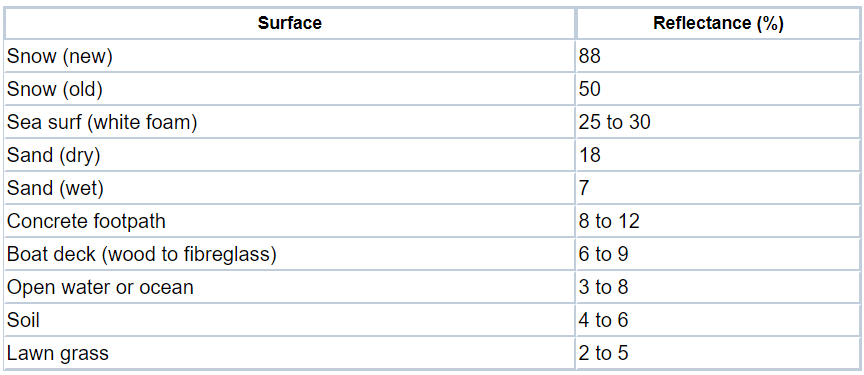
What about the hole in the ozone layer?
The ozone layer is great. It helps to shield Earth from all of the most dangerous part of ultraviolet (UVC), and 90% of UVB. Without the ozone layer, life would be very different. If the ozone layer disappeared, most scienticians agree that civilisation would rapidly devolve into warring clans of disfigured mutants, making for a horrible existence but a kickass movie.
Fortunately, so far man has destroyed only 5% of the ozone layer. Thus the risk of sunburn and skin cancer has increased since the 1980s (when ozone depletion was first identified), but only by a small amount.
Unless you’re in Antarctica that is, where a ‘hole’ in the ozone layer now forms each spring. Provided you’re not on an Antarctic expedition then you’re safe – the hole has never reached as far north as Australia or New Zealand.ref
Is it sunburn that causes cancer? Or just being in the sun?
Probably both.
The science on this aspect is particularly uncertain. It seems that:
- Sunburn is important to the likelihood of developing melanoma, which is the most dangerous form of skin cancer. Especially when the sunburns are severe and/or happen in childhood (less than 10 years old, but possibly into late-20s).ref
- Conversely, avoiding sunburn but spending a lot of time in the sun makes other forms of skin cancer more likely.ref
- There’s likely some degree of crossover i.e. more exposure of either form (especially when youngerref) makes any type of skin cancer more probable.
Also keep in mind that:
- After peeling from sunburn, the newly revealed skin is temporarily more vulnerable to UV than its dead predecessor.
- One part of the UV spectrum, UVA, doesn’t typically cause pain or sunburn. Even so, it’s thought to cause cancer, and to degrade the cosmetic appearance of skin e.g. wrinkles, dryness, sagging, and mottled pigmentation.ref
- UV impairs the immune system, potentially aggravating infections in the skin and elsewhere. Eyes can be damaged by both cumulative UV exposure over the long-term (e.g. cataracts) and intense, short-term doses (e.g. snow blindness, welders flash).ref
Does a tan protect against sunburn and cancer?
Sunburn: Yes, a little. Cancer: No.
Human skin contains various amounts and types of melanin, which is the primary determinant of our skin colour. It is also the chief defence against ultraviolet radiation, being extremely effective at absorbing UV rays before they damage other cells.
Skin that is naturally dark due to melanin is far more resistant to the effects of ultraviolet. Compared to fair skin, dark skin can absorb 30 times more UV before burning. Darker skin also repairs DNA damage more efficiently.ref
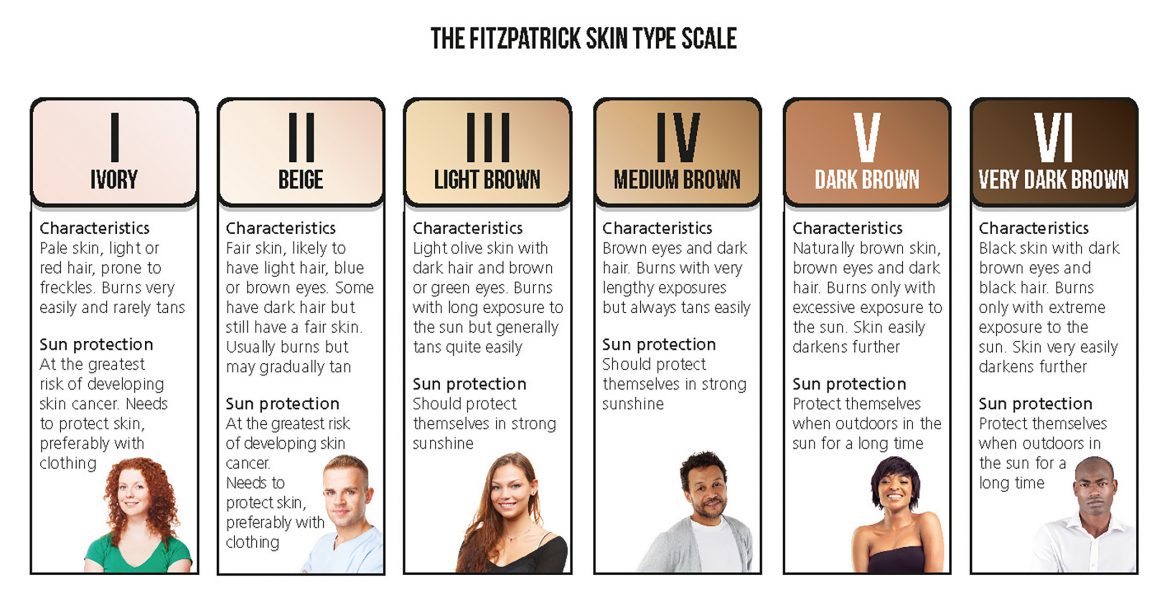
UV exposure varies across our body (according to the type of outdoor activity), as does UV resistance. For example, limbs are 2-4 times less sensitive than our face, neck and torso.ref
Two processes are set in motion when UV enters our skin. Near to the surface, UVA causes existing melanin to rapidly darken and/or move outwards, while UVB triggers the production of new melanin.ref Both processes darken the skin i.e. create a tan. The UVA-induced tan comes and goes quickly (hours), while that from new melanin takes a few days to appear but generally lasts for many weeks.ref The skin also thickens for a couple weeks after UVB exposure. In lighter skin types, this thickening may contribute more to UV protection than the extra melanin production.ref
A moderate UVB tan on relatively fair skin is believed to protect against sunburn equal to a SPF 3 sunscreen. But a tan hasn’t been shown to offer similar protection against cancer or visible ageing.ref Plus, some amount of damage must be incurred to induce the tan: for poor tanners (i.e. Caucasians), the required dose is close to that which will cause sunburn.ref Damage must be repeated regularly to maintain a tan, as all skin cells eventually die and are shed (this is why suntans fade). ref
So, is it worth chasing a tan to boost your sun protection in the weeks ahead? It will be interesting to see what researchers uncover on this in coming years. Until then, I’d say if it happens, it happens, but to make it a goal would be unwise. Even if shown to be theoretically beneficial, it’d likely be a nightmare to implement properly: a body’s worth of skin that faces every direction, all needing enough-but-not-too-much exposure while UV levels fluctuate with every passing cloud. All for protection that’d still be inadequate in many circumstances. Instead, better to focus on finding a hat you look good in.
P.S. a fake tan definitely doesn’t help. Typically these products stain the skin darker with a dye, which gives no additional protection.ref
What about sunscreen?
Active ingredients in sunscreen reflect and/or absorb incoming UV. The sunscreen’s SPF (Sun Protection Factor) rating is the maximum portion of the UV that the skin to which its applied will absorb. So SPF30 sunscreen allows only 1/30th of the UV through, and SPF50 1/50th. Expressed another way, SPF50 blocks 98% of UV radiation, an increase of only 1% over SPF30’s performance.

In practice, the SPF rating is how many times longer you can be exposed to the same conditions and experience the same level of sunburn. For example, on a day where you spend 5 minutes in the sun before burning, wearing SPF30 sunscreen will extend this to 150 minutes.
SPF ratings only hold true if sufficient sunscreen has been applied. For an adult body, this is at least one shotglass worth (30ml+). Further, SPF only considers the main cause of sunburn: UVB. A sunscreen labelled as ‘broad-spectrum’ will protect equally against UVA as well. ref
In addition to sunburn, sunscreen reduces visible ageing of the skin, and decreases the likelihood of developing most forms of skin cancer, including melanoma.ref
‘Reapply every two hours’ is the typical advice, but there’s little consistent information on why exactly. What is clear is that two hours is an overstatement, intended to offset the fact that most people use too small a volume when applying.
Sunscreen is removed by swimming, sweating, and friction (from towels, sand etc.), particularly those which use minerals to physically block UV. In these circumstances, reapplication would be required at some point. The other type of sunscreen, which absorbs and dissipates UV chemically, may or may not get ‘used up’ by sun exposure, depending on who you ask.
At least for someone indoors and not sweating, sunscreen will still provide protection even if it was applied more than two hours earlier. For example, an office worker who put on sunscreen before work (e.g. via SPF-rated cosmetics) may not need to reapply before heading out for a lunchtime stroll.
Recap
We’ve covered a lot, so here are some of the key points to remember:
- Sunburn, tans, some wrinkles and spots, peeling skin: all are evidence of radiation damage.
- To avoid harm to your skin, you need to deliberately think. You can’t rely on your body’s signals because by the time you feel sunburn, it’s too late.
- Sunburn is extra bad, but total time in the sun also drives skin cancer risk and skin ageing.
- Consider sun elevation and cloud cover, rather than temperature.
- Sunscreen may not discourage all types of skin cancer, plus UV causes eye damage, so there’s still a role for appropriate clothing and shade.
- Don’t get hung up on the SPF of sunscreen, instead focus on applying enough.
Hopefully, this article helps you make informed decisions to balance the good and the bad which comes with spending time in the sun.
Did you like this article?
Do you like this site?
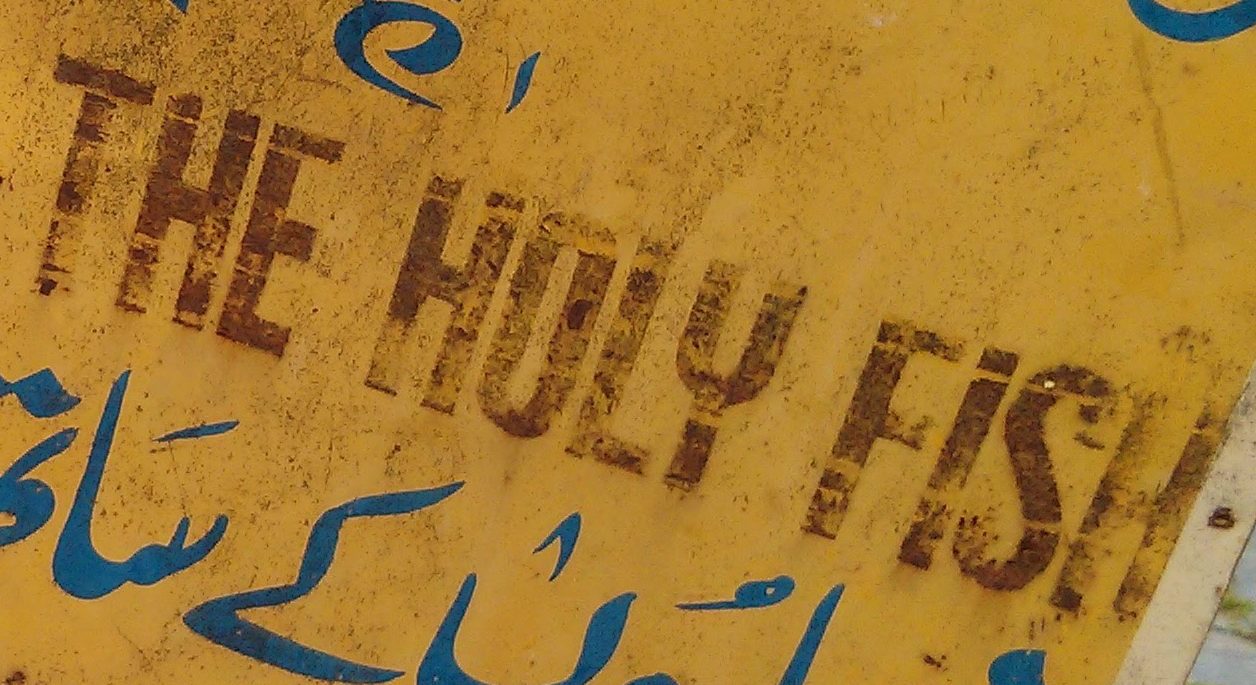
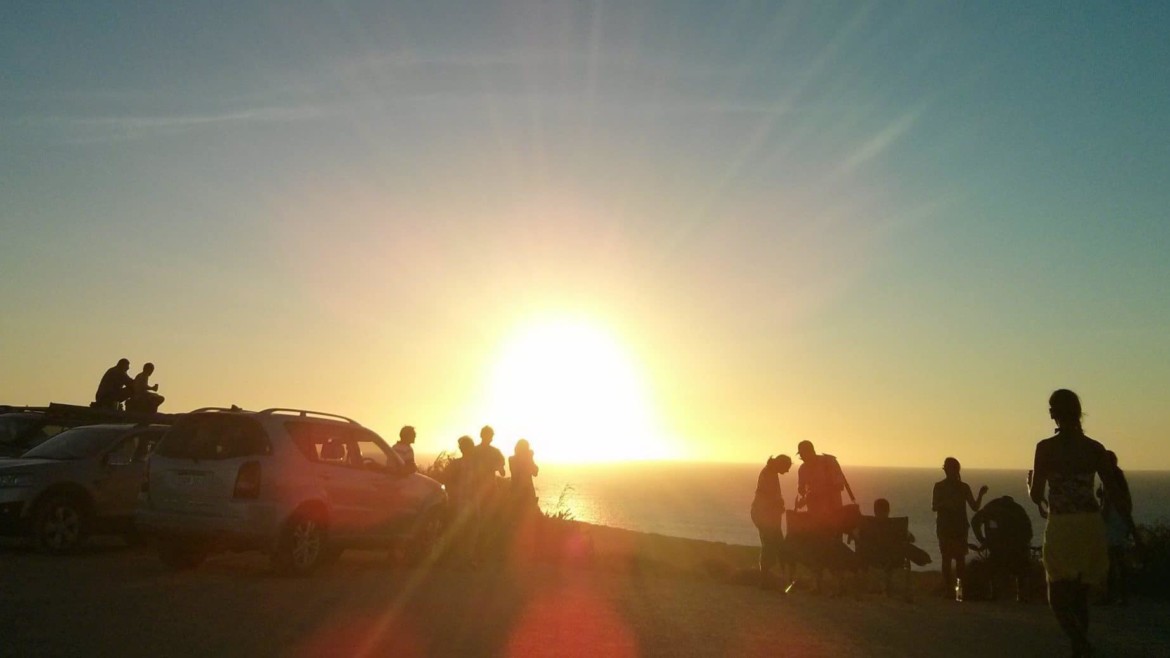
Very interesting but doesn’t shed much light on why in my youth the sun made me look like a bronzed islander child and why now i look like an irish backpacker after 10mins